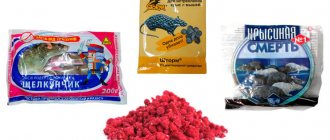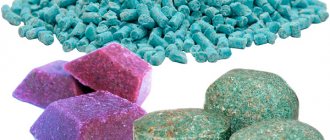At the beginning of winter, with the first frosts, mice, driven by hunger and cold, begin to invade human habitation. Mice in the house are always a huge headache for owners. They not only spread dangerous infections and announce their presence with a peculiar mouse odor, but also damage building structures, communications, and furniture. In this article we will look at:
- Why do mice try to get into the house?
- Mice in a private house: what wall material do rodents prefer?
- What to do to prevent mice from entering your home?
- How to get rid of mice in the house.
Mice in a private house
Hunger and cold drive mice into human homes. In summer, rodents can feed in fields and vegetable gardens, and with the onset of frost they run to where there are food reserves.
Mice have an excellent sense of smell; they can sense food at a distance of two kilometers.
A bag of flour in the pantry, bags of cereal in the kitchen cabinet... All this is like a magnet for mice.
And if the house is not protected from rodents at the construction stage, nothing and no one can stop the mouse that is trying to get into the house.
In addition to the smell of food, human housing attracts mice due to heat leaks.
The better the house is insulated, the better the heat is contained and the less it leaks out, the less it attracts rodents.
There is such a recommendation: with the onset of winter, it is good to heat the house and check it with a thermal imager. Places of heat leaks will usually be entry points for mice into the house. It is important to fix leaks as quickly as possible.
Typically, several large family mouse colonies (a male, several females and cubs) live in one private house. In a heated house with artificial lighting, mice cease to keep themselves within the boundaries determined by nature: they breed all year round (and not just in summer), they can be active at any time of the day (and not just at night), etc.
Over the course of a year, a female house mouse produces on average about 10 litters of 3-12 cubs each.
And all this horde of mice is constantly gnawing on something. Mice cannot do otherwise: the incisors of these rodents grow throughout their lives, and they must constantly grind them down so as not to die.
Mice in the house gnaw through plastic pipes and wiring, get into household appliances and cause short circuits, damage walls, floors, furniture...
Folk ways and methods of poisoning rats
Rats are vermin that can spread disease and also compromise the structural integrity of your home. Most commercial poisons promise to effectively kill rodents, but they contain extremely toxic chemicals that also pose a danger to humans and pets.
If you need to poison rats, you can prepare rat poison, which will be much safer than its chemical counterparts, at home. Below are various rat poison recipes.
Homemade Rat Baiting Remedy
- Mix 100g plaster of Paris and 100g cornflour in a small, possibly disposable bowl. Plaster of Paris can be purchased at most craft and hardware stores. It is a dry powder that, when mixed with liquid, expands in volume and eventually hardens.
- Add 1-2 cups (0.2 - 0.5 l) milk. You can add more milk if the clumps of cornmeal or gypsum remain dry.
- Knead this mixture into a dough by hand.
- Tear off and roll 2.5-5 cm balls from the resulting dough.
- Place the balls behind the refrigerator, inside cabinets, under the stove, or other places to bait rats.
- Wait a few days and check the balls to determine whether they have been eaten or not.
If some of the balls were not eaten, you will have to make another batch of poison and place the poison in other places. The plaster will harden and the bait will become inedible over time.
How to get rid of a rat in an apartment
- Mix 130g flour, 1 cup (200g) sugar and 130g baking soda in a large bowl.
- Place the dry mixture in shallow containers, such as canning jars.
- Wait one day and check the jars.
This is another effective way to control rats in your home because the bicarbonate in baking soda reacts with the rat's stomach acid and produces carbon dioxide gas. Rats cannot regurgitate gas formed in the stomach. The gas will accumulate in the rat's digestive system, which will ultimately lead to the death of the rodent.
Methods to control rats
Methods to control rats
- Combine one package of dry (cooked) potatoes and a cup of plaster of Paris in a large bowl.
- Add a pinch of cinnamon to the mixture.
- Add one glass of water to the bowl.
- Stir the mixture and form small balls from the resulting dough.
- Place the balls (or mixture in canning jars) in areas where rodents live.
Adding a little peanut butter to your poison bait will help you attract and kill rats faster. Make sure you find dead rodent carcasses, as decomposing rodents can fill your home with an incredible stench that will linger for months and is also potentially hazardous to your health.
Advice!
Do not leave rat poison where pets or children can reach it. Even though homemade rat poison is less toxic, it is made from substances that are hazardous to health if ingested.
Unfortunately, it is impossible to get rid of rats using absolutely safe means for humans and pets. Wash and thoroughly disinfect the bowls in which the poison was mixed if you plan to use them in the future. It is better to use disposable tableware.
Why are mice dangerous in the house?
Mice in the house are carriers of pathogens of many parasites and dangerous diseases.
Here are just some of the diseases that mice can infect humans:
- toxoplasmosis,
- salmonellosis,
- leptospirosis,
- tularemia,
- bartonellosis,
- hantavirus infection.
- different types of fevers.
Fleas and ticks can live on mice, which quickly spread to pets and people. Mice also carry eggs of different types of helmites.
Harm to humans
Mice are primarily a source of infections. They can carry many diseases that can be transmitted to humans, from intestinal infections to tuberculosis.
READ ALSO: Electromagnetic and ultrasonic rat and mouse repellers: which device is better and how to use it
They spoil all the things they can get to - they gnaw on supplies, make nests in things stored for storage, gnaw passages in the walls and floor, disrupting the thermal conductivity of the room.
Rodents are extremely allergic. Their fur, saliva and excrement can cause a severe asthma attack in a person prone to this disease.
Mice smell extremely bad and it is very difficult to get rid of the smell of their waste products.
How mice get into the house
Mice enter homes in a variety of ways. Here are the most common:
- Through passages in the ground . Mice dig under the foundation lining and end up under the floor, from where they climb into the house through cracks or gnaw holes in the floor, in corners, etc.
- Through the wind holes . The mice perceive vents unprotected by bars in the foundations as hospitably open doors. Mice can live in ventilation ducts, penetrating through them into the structure of walls, ceilings, etc.
- Through building materials . Mice, not as rarely as we would like, settle in large foam and aerated concrete blocks, ready-made frame structures insulated with foam plastic, etc. These cunning rodents can hide in a building element and wait until the installation of the structure is completed.
The location of the house in the mouse issue is more important than the material of the walls: if the building is located not far from the field, then in the fall dozens of mice will be attracted to it.
But if you protect the house (and better at the construction stage), close all the cracks, cover the holes with bars, make the floor structure insurmountable for rodents, then they, realizing the futility of their attempts, can forever forget the way to this building.
How to make an expanded clay mouse lock
Expanded clay lock prevents rodents from entering the house through the floor. With this method, expanded clay is included in the floor cake. Here is the floor pie (from the ground):
- layer of expanded clay (30 cm or more),
- polyethylene film;
- two layers of OSB-3;
- expanded clay;
- OSB impregnated with boric acid and synthetic wax.
Expanded clay will become a mechanical obstacle for mice, and boric acid will act as an additional chemical repeller until it wears off.
Another way to protect your floor is to cover all cracks with galvanized steel strips. In this case, the floorboards are laid directly along the joists, without insulation, the cracks are covered with wide (about 10 cm) strips, they are nailed to the floor, and the top is covered with insulation and sheathing.
Organic repellents
Many manufacturers of organic products used in agriculture offer a wide range of rodent repellents. These products are less harmful to nature and humans compared to pesticides. Repellents contain natural substances, such as peppermint, that force pests to find a new home. Such organic preparations are available in aerosol form and are sold in stores selling home and garden products.
How to get rid of mice in the house forever: metal mesh
Biologists say that a mouse will fit even into a hole that would be impossible to insert a pencil into. This is true. The mouse has a very flexible skeleton, and its skull “folds” like that of a baby during childbirth. Therefore, a galvanized mesh to protect against mice must consist of the smallest cells. The second requirement is that it must be made of very durable metal.
The mesh should be made of wire thicker than 2 mm, the cell dimensions should be no larger than 10x10 mm.
The mesh is laid on the subfloor.
They're wrapping her foundation
Or they close the ventilation holes.
All corners are covered with fine mesh (as reinforcement for plaster). It is important not to miss a single corner, not a single joint.
The ventilation gap between the insulation and the sheathing below is also covered with this mesh: you should get a box with walls at least 5 cm high.
Also, a fine-mesh mesh is buried in the ground along the perimeter of the foundation to a depth of 80 cm so that mice cannot dig under it.
To protect against mice, the base is lined with fine-mesh mesh at least a meter in height.
Professionals advise laying fine mesh wherever a mouse could theoretically sneak through.
For additional protection of the base, it is recommended to sheathe it to a height of at least a meter:
- corrugated sheet made of structural steel 1.5 mm thick (in waves lengthwise);
- slippery smooth plastic;
- plaster (but to prevent the mouse from chewing through the plaster, the top is finished with acrylic putty and slippery paint is applied to the putty).
Types of bait
The standard idea, drawn from a popular cartoon, is that mice are ready to fight to the last drop of blood for a piece of cheese.
In fact, this concept is completely wrong. Rodents react much faster to natural and familiar food, such as grain, bread and some smells. To effectively lure mice, it is better to use a fresh piece of aromatic bread , which is additionally moistened with aromatic unrefined sunflower oil. It must be said that using sesame oil instead gives a greater luring effect. Sesame does not grow in our country, but its smell is so attractive to mice that just a drop of oil from this plant will attract a large number of rodents.
How to get rid of mice in the house
It is very difficult to get rid of mice in your home forever.
- Various repellers emit such signals that the owners want to escape from the house along with the mice.
- Poisoned baits will mean that there will be mouse remains lying somewhere in a secluded corner.
- Mice easily get caught in mousetraps, even homemade ones: catching a mouse with a plastic bottle works great. To do this, you need to pour a little oil into the bottle (preferably the kind you used to fry fish or sunflower seeds). The same oil should be used to thoroughly coat the neck of the bottle from the inside and strengthen it at an angle of 45 degrees. The mouse will become a victim of its legendary sense of smell - it will definitely climb into the bottle, but will not be able to get back out.
- A good cat can also help. If a real seasoned mouse catcher settles in the house, the mice will most likely leave the room.
Mechanical traps (mousetraps)
The list of structures that are used to combat unwanted neighbors is very long. Devices for catching pests are constantly being improved and modified. Mousetrap with frame
This is a long-known structure with a base made of wood, metal or plastic, to which a metal frame and spring are attached. When the mouse grabs the bait, the mechanism is triggered and the frame kills the rodent.
Minuses:
- False alarm, jamming.
- Mice learn to deceive the structure and drag the bait with impunity.
- Low degree of effectiveness with large numbers of mice.
The disadvantages of a mousetrap include the fact that after the mousetrap has fulfilled its intended purpose, the caught rodent must be removed, after which the device can be reused.
Mouse trap
Summarizing
Fighting mice is a difficult and nerve-wracking business. It is much better to protect your home from their entry by choosing the right building materials and using chicken wire to protect the foundation and vents.
FORUMHOUSE has an excellent collection of ways to protect facades, ceilings and foundations of houses from mice. Find out how to protect your garden and vegetable garden from mice. Read our articles about humane methods of controlling moles and other garden pests: mole crickets, pests that attack wood. Watch our video on how to save a tree that has been chewed by mice.
Subscribe to our Telegram channel Exclusive posts every week
Exterminating rodents with perfume
To repel rodents, formaldehyde or kerosene has long been successfully used, the smell of which is so disliked by mice and rats. But these liquids can only be used to protect non-residential premises. I recommend that you spray the corners of the cellar or basement with formaldehyde or kerosene and the rodents will immediately leave there.
If you yourself do not like the smell of kerosene, then you can take a piece of old rubber, place it in a bucket and burn it on the fire using a blowtorch. It is better to do this while storing food in the cellar.
Well, if you are somehow not satisfied with all of the above methods, try another one. Mice and rats cannot stand the smell of mothballs. Make a mixture of equal parts of naphthalene derivatives and sawdust and sprinkle it near mouse holes, passages and holes.
Mice can be effectively exterminated with turpentine, the smell of which they cannot tolerate. To do this, soak a rag in turpentine and place it in the hole. After a few days, this operation must be repeated.
Reinforced concrete method of fighting rats and mice
Reinforced concrete method of fighting rats In order to prepare a cellar or underground for storing food, all existing holes must be filled with glass, stoned or concreted, and the supply and exhaust pipes closed with a fine metal mesh.
A week before storing food, you should disinfect the room with a bleach solution.
And I recommend smoking the cellar, which is located outside the residential premises, with a sulfur bomb before storing the harvest.
This is done like this: we plug up the vents and cracks in the room being treated. Light the wick and close the door tightly. The smoldering time of the checker is about 1 hour, the time of the cleansing effect of the smoke is 24-36 hours. After this, it is necessary to ventilate the cellar well for 1-2 days until the smell disappears completely. And your cellar will be cleansed of fungus, mold, rot, and insects. And the rodents will run away.
Marine method of getting rid of rats
One day, while sitting on a rubble, I heard about an ancient maritime method of fighting rodents. It is said that several healthy adult rats were placed in a strong metal barrel. Left without food, they began to devour each other.
Attention!
The surviving rat was released into the hold of the ship, where it found and ate all its relatives. Today, the method is not relevant, since it requires a strictly limited space for the activities of the surviving individual: otherwise you raise a monster and it will run away to another place. Yes, and there are simpler and less bloodthirsty methods of controlling rodents.
We exterminate rats with vodka.
And the last method of exterminating rats - you don’t know for sure - is with the help of vodka. Frol Fomich’s eyes sparkled slyly: “Here, dear man, you can’t get away with a wine cork, you’ll need half a liter for a scientific experiment.” I had to respect the old man.
Before his story, they took a sip of a glass. From a good conversation and a drink, Frol Fomich became slightly tired and he snored sweetly and took a nap on the rubble. I didn’t wake him up, so Frol Fomich will tell you about fighting rodents with alcohol next time.











